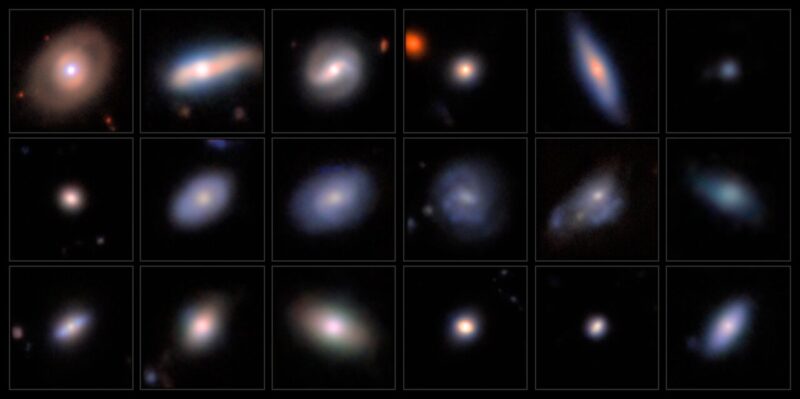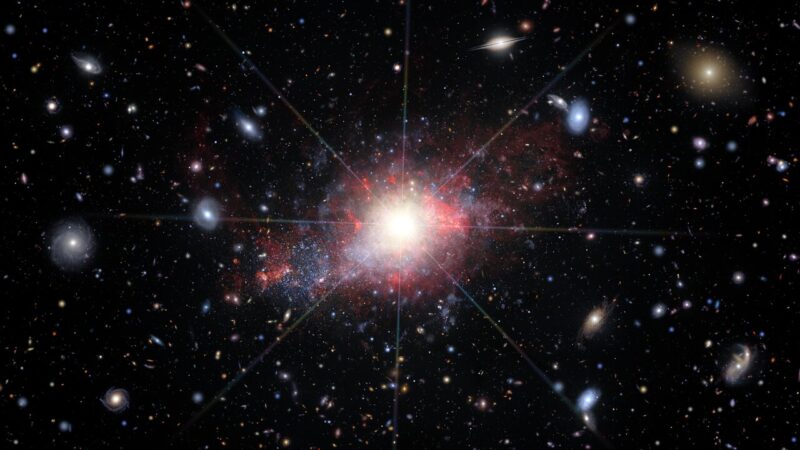Using the Dark Energy Spectroscopic Instrument (DESI) at Kitt Peak in Arizona, astronomers have discovered thousands of new black holes. These discoveries have more than tripled the amount of known intermediate-mass black holes and active black holes at the centers of dwarf galaxies. Images and videos: NOIRLab/NSF/AURA/J. da Silva/Legacy Surveys/D. Lang (Perimeter Institute)/NAOJ/HSC Collaboration/D. de Martin (NSF NOIRLab) & M. Zamani (NSF NOIRLab)/R. Proctor (NSF NOIRLab)/R.T. Sparks/ESO/M. Kornmesser/N. Bartmann (NSF NOIRLab) Music: Stellardrone – Airglow.
Thousands of new black holes
The number of black holes we know of in space has just ballooned. On February 19, 2025, NOIRLab said its astronomers have discovered thousands of new black holes. The number includes 300 intermediate-mass black hole candidates (weighing in at weighs between 100 and 100,000 times the mass of the sun). Plus, it includes some 2,500 candidate dwarf galaxies with black holes that are actively feeding at their centers.
These discoveries more than triple the census of black holes in both categories.
The mission of the Dark Energy Spectroscopic Instrument (DESI) on the 4-meter Mayall Telescope at the NSF Kitt Peak National Observatory in Arizona is to survey millions of galaxies. It can capture the light of 5,000 galaxies at once! The researchers used DESI to find the new black hole candidates inside distant galaxies. And the discoveries came from just a fraction of the data that the five-year survey will produce. The researchers used only data from the survey validation and 20% from the first year of operations.
Co-author Rahma Alfarsy of the University of Portsmouth said:
Having witnessed the development and outcomes of this brilliant work, we are really excited to see what else will be unearthed from DESI’s treasure trove of extra-galactic observations.
The researchers published their peer-reviewed results in The Astrophysical Journal on February 19, 2025. A copy is available on arXiv.
The 2025 EarthSky lunar calendar makes a great gift. Get yours today!
Surveying a slew of galaxies
The team – led by University of Utah postdoctoral researcher Ragadeepika Pucha – looked at the spectra of 410,000 galaxies. About a quarter of those were dwarf galaxies.
Astronomers already know that a monster black hole lies at the center of the Milky Way galaxy. And they think similar black holes lie at the centers of other large galaxies. But the smaller the galaxy, the murkier the picture. When looking at dim, distant dwarf galaxies, the best bet at finding a black hole is to look for an active galactic nucleus. That signals that a black hole is feeding on stars at its core.
Pucha said:
When a black hole at the center of a galaxy starts feeding, it unleashes a tremendous amount of energy into its surroundings, transforming into what we call an active galactic nucleus. This dramatic activity serves as a beacon, allowing us to identify hidden black holes in these small galaxies.

Intermediate-mass black holes
The team also identified 300 intermediate-mass black hole candidates. This size of black hole can provide the missing link between two more common black holes. We know of many supermassive black holes lurking at the centers of galaxies. And we know of stellar-mass black holes, formed when massive stars explode as supernovae. Intermediate-mass black holes might be relics of the first black holes.
These mid-range black holes are harder to find. Unlike stellar-mass black holes, they aren’t preceded by a large supernova explosion. And unlike supermassive black holes, they don’t have a radio- and X-ray-bright glowing accretion disk.
Interestingly, astronomers thought the black holes at the centers of dwarf galaxies would be of an intermediate-mass size. But in this research, only 70 of the new candidate intermediate-mass black holes overlap with candidates of dwarf galaxies with active galactic nuclei. This raises more questions. Pucha said:
For example, is there any relationship between the mechanisms of black hole formation and the types of galaxies they inhabit? Our wealth of new candidates will help us delve deeper into these mysteries, enriching our understanding of black holes and their pivotal role in galaxy evolution.

Bottom line: Scientists have discovered thousands of new black holes, more than tripling the number we knew before. How’d they do it? Read more here.
Source: Tripling the Census of Dwarf AGN Candidates Using DESI Early Data
Source link
Read More
Visit Our Site
Read our previous article: Address science misinformation by building community
